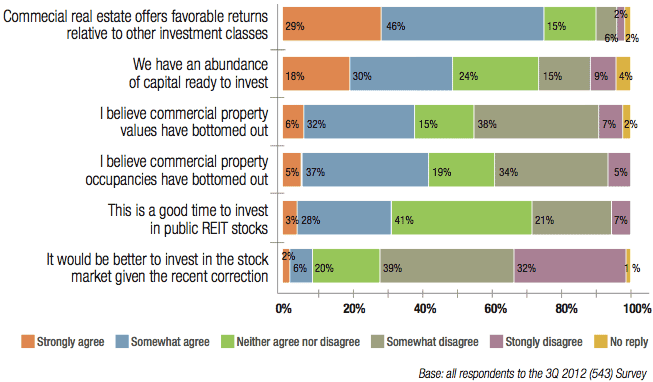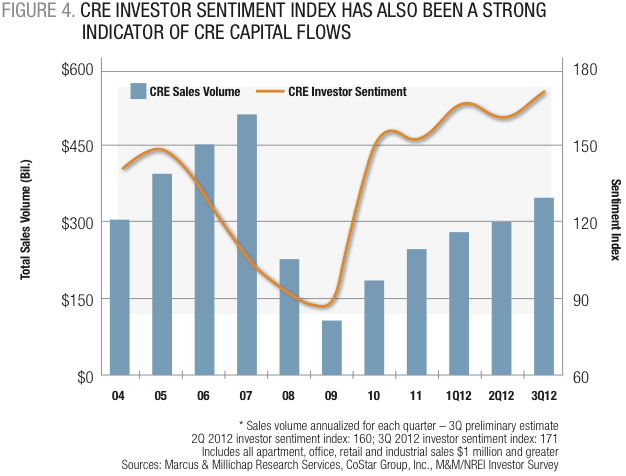Low interest rates, jobs offset fiscal cliff concerns
Investor Confidence Surges — The latest results from the NREI/Marcus & Millichap Investor Sentiment Survey show that investor confidence is not only surging forward, but investors also are preparing to accelerate their commercial real estate buying in the coming months.
After taking a slight step back in second quarter, the Investment Sentiment Index moved five points higher to 171 in third quarter. That is a significant milestone as it marks the highest level the index has achieved since the survey first began in 2004. The Investment Sentiment Index measures investor views on key fundamentals such as improving occupancies, rising property values and plans to increase commercial real estate holdings. The index and broader survey results reinforce views that investors are gaining confidence in both the economic and commercial real estate recovery.
“If the Index’s historical accuracy holds, the surge to 171 tells us that the economy is headed in the right direction,” says Hessam Nadji, a senior vice president and managing director at Marcus & Millichap in Calabasas, Calif. Historically, the index has proved to be a very good indicator of what happens in the economy. Since hitting a low point of 92 in 2008, investor sentiment has been making steady gains, albeit with a few starts and stops along the way. “Looking back further, sentiment started to turn negative in 2005, well before the economic downturn and more recently, the modest drop in sentiment in the spring of this year was contrarian to the rising tide of concerns of a double-dip recession. Based on that past history, the current index tells us that we should be experiencing better job growth in the first half of 2013,” adds Nadji.
The positive investor sentiment is a re- flection of the improvement to some key economic performance indicators, as well as government actions that occurred in late summer and early fall. The European Union has made progress in putting forth a broader backstop to its debt crisis. Quantitative Eas- ing III confirmed the Federal Reserve Board’s commitment to keeping interest rates low for an extended period and being accommodative as long as it takes to see a more robust economic recovery. “Low interest rates and more financing sources have had a significant impact on rising investor sentiment and sales,” says William E. Hughes, senior vice president, managing director of Marcus & Millichap Capital Corporation.
The one cloud on the horizon that could derail the economic recovery is the looming “fiscal cliff” combination of automatic tax in- creases and spending cuts scheduled to hit in January of 2013. “The underlying expectation by the survey participants is that lawmakers will likely postpone these measures given the complexity and polarized views on taxation and spending. It appears that lawmakers on both sides of aisle recognize the severity of the blow to economy, which is estimated at 5 percent of GDP,” says Nadji.
Buyers poised for acquisitions
Investors have assumed a defensive position as they sought to weather the economic storm. Buyers have gravitated to the relative “safety” of class-A properties in core markets. As investor confidence in the commercial real estate recovery grows, buyers appear ready to start an aggressive strategy with a bigger appetite for commercial real estate and more tolerance for risk.
Nearly two-thirds of investors (62 percent) plan to increase their commercial real estate investment in the next 12 months. That sentiment has edged higher compared to the first and second quarter surveys where 59 percent of respondents planned to increase holdings. Among those who expect their real estate investment to increase, respondents expect their portfolios to grow by nearly a quarter or 23 percent. That is considerable given that the average respondent has $41.6 million invested in commercial real estate.
Sales volume in the four major property sectors reached a low point of $100 billion in 2009, down from a peak of over of $500 billion reached in 2007. During the first half of 2012, sales volume reached an annualized rate of nearly $300 billion according to Marcus & Millichap Research and Real Capital Analytics.
Large, institutional-quality class-A properties in major metros have led sales activity during the early stages of recovery. However, investors are exhibiting more tolerance for class-B and B- properties, value-add opportunities and second-tier markets, notes Nadji. Investors are expanding their parameters in part due to a quest for higher yields. Cap rates have continued to compress for top-tier properties. For example, mid- and high-rise apartment properties have been selling at average cap rates below 5 percent for more than 12 months with numerous examples of trades in the 4 percent range, according to RCA. “We’re still seeing that underwriting is tight and very much scrutinized. The standards are not loosening, but the risk appetites are beginning to expand,” adds Nadji.
The growing risk tolerance also mirrors the growing confidence in commercial real estate as an investment, as well as confidence in the market recovery. Three out of four respondents agree that commercial real estate offers favorable returns relative to other in- vestment classes, while only 8 percent believe it would be better to invest in the stock market than commercial real estate. Only about one- third (31 percent) think now is a good time to invest in public REIT stocks.
In addition, nearly half of respondents somewhat or strongly agree that commercial property values and occupancies have bottomed out at 53 percent and 50 percent respectively. That growing sentiment is prompting many investors to consider increasing their buying now in order to capitalize on market opportunities. “The market is on a slight up- turn, and as a developer, I feel I need to have my assets in place prior to when the market upswing picks up. Plus, it is a good time to invest in assets with the prices down,” wrote one respondent.
Low interest rates and greater access to capital are other key drivers fueling positive investor sentiment. Respondents continue to report that the availability of financing has increased over the past six months. Over half of investors (56 percent) believe financing is slightly or much more available than it was six months ago, while 28 percent see the availability of financing as unchanged and 6 percent believe financing is less available compared to six months ago. Eight percent of respondents have not attempted to borrow any money in the past six months. In addition, 52 percent say they have an abundance of capital ready to invest.
Apartments still rule
Apartments will continue to be the preferred investment type over the next year due to strong occupancies and rent growth, as well as the fact that apartments are viewed as a lower-risk investment if the economy were to stumble. Overall, 53 percent of apartment investors believe now is the time to buy more.
Three out of four respondents also expect the value of apartments to increase 12 months from now. The average increase expected is down slightly from the 7.3 percent predicted in the second quarter survey with respondents anticipating a 6.3 percent hike in the coming year.
That being said, the strong performance in rent and occupancy growth among class- A properties may be difficult to duplicate. Apartments, especially the class-A sector, have recovered to full occupancy and, in most cases, also returned to pre-recession rent lev- els. Year-over-year vacancies dropped from 5.9 percent in 2011 to 4.7 percent in second quarter 2012, according to data from Marcus & Millichap and Reis. Effective rents that have been rising by 4.5 percent for the past 18 months are likely to see a moderation in the pace starting in 2013.
Although class-A properties will remain strong, class-B and class-C properties will likely see bigger gains in the coming year. “They are just now starting to come into that sweet spot of vacancies coming down and rent growth accelerating. So I actually think that over the next 12 months, class-B and class-C rents will accelerate more and class-A rents will level off,” notes John Sebree, vice president and national director of Marcus & Millichap’s national multi housing group.
Industrial stays strong
Industrial is poised to have a very strong year in 2013 as fundamentals continue to improve in that sector. Half of industrial investors believe now is the time to buy more, while 35 percent say that it is better to hold, 12 percent think it is a good time to sell and 3 percent had no response.
“My expectation would be for industrial to outperform over the next 12 months, be- cause it has burned through its excess sup- ply,” says Alan Pontius, managing director of Marcus & Millichap’s national office and industrial properties group. “The movement of goods is happening parallel to a better economic environment, and even manufacturing is showing signs of life with over 170,000 jobs created in that sector over the past 12 months.” Year-over-year industrial vacancies improved from 12.3 percent in 2011 to 11.5 percent as of second quarter 2012, according to Marcus & Millichap and CoStar Group.
Investors remain consistent in their views of industrial properties. Forty-eight percent of industrial owners believe that the value of industrial properties in their own portfolios will increase in the coming year, while 45 percent expect values to remain the same, 5 percent expect a decrease and 2 percent had no response. The change in industrial values is expected to be positive with an average increase of 3.7 percent anticipated.
Retail faces headwinds
Although retail has come a long way in the past year, recent lackluster retail sales numbers in the spring and summer injected a note of caution into retailer expansion plans. Retail tenants may take their foot off the gas a little bit, but the last few months’ trends have improved somewhat as have home sales and price trends, setting the stage for at least a moderately stronger holiday shop- ping season,” says Bill Rose, national director of Marcus & Millichap’s national retail group. “The next few months are likely to have some volatility depending on the treatment of the fiscal cliff by Washington and impact of Hurricane Sandy.”
Overall, 46 percent of retail owners expect their property values to rise in the coming year, which is comparable to both first and second quarter survey results. However, the average expected change did drop from 4.8 percent in second quarter to 2.8 percent in the current survey. Another notable change is that fewer retail owners believe that now is the time to buy more. While 50 percent of retail owners surveyed in the first half of 2012 believed it was a good time to buy more, that figure has dropped in the current survey. Now an equal number of retail owners (44 percent) believe now is the time to hold their retail properties, while 40 percent believe it is a good time to buy more, 12 percent believe it is time to sell and 4 percent had no answer.
More retailers are stepping up expansion and store openings, which have helped to ab- sorb the surplus of space still on the market. For example, Dollar General announced plans to open 650 stores in 2012, while CVS was planning to open 300 new stores this year. Year-over-year retail vacancies declined from 10 percent in 2011 to 9.7 percent in second quarter 2012. Effective rents also show signs of stabilizing with a slight gain of 0.4 percent in effective rents evident in second quarter, according to data compiled by Marcus & Millichap, CoStar and Reis.
Office sentiment rises
Investor sentiment for office rose more than any other product type with an index level that jumped from 123 in the second quarter to 135 in the third quarter. “I think that is a reflection of office having been the laggard in this recovery so far,” says Pontius. Many companies have been saddled with excess office space, while other businesses are taking steps to reduce their real estate footprints and use existing space more efficiently.
Forty-six percent of those investors that already own office properties believe that values will rise over the next 12 months, which is a marked increase compared to the 36 percent who held the same view in second quarter. Forty-two percent believe values will remain the same, while 11 percent expect a decrease and 1 percent had no response. The average change expected also jumped from 1.6 percent in second quarter to 3.1 percent in the current survey.
“Investors feel that the bottom has definitely been reached for office, and if we get a little bit better economic performance going into 2013, the translation for office demand is bound to be much better in 2013 than any- thing we have seen since 2007,” says Pontius. Over the past year, vacancies have improved slightly from 17.5 percent in 2011 to 17.2 per- cent as of second quarter 2012, according to data from Marcus & Millichap and Reis. In addition, effective rents posted a gain of 2.0 percent in second quarter.
Hotels hold on
Confidence in hotels remains strong. Over half of hotel investors (51 percent) believe now is the time to buy more. In addition, nearly two- thirds of respondents (62 percent) expect their property values to increase in the coming year. The average change in value expected is a 5.9 percent increase, which is greater than the 5.0 percent increase expected in second quarter. “If you think the economy is going to do better, it’s not a surprise that you think the hospitality sector is going to do better, because both business and leisure travel will increase,” says Gregory LaBerge, director of Marcus & Millichap’s national hospitality group. Key hotel performance metrics have been trending positive. In year-over-year comparisons, hotel occupancies for the week of Sept. 23-29 rose 2.5 percent to 64.2 percent. The average daily rate rose 5.4% to average $106.60, and revenue per available room in- creased 8% to $68.43, according to Hendersonville, Tenn.-based STR Global.
Top concerns: economy politics
Despite the positive sentiment, the economy remains the No.1 concern for the vast majority of investors (88 percent). Most agree that the political climate will impact several key issues in the coming year. In addition to the economy, respondents rated their top concerns as the political uncertainty/logjam in the U.S. at 55 percent; large federal and state budget deficits (57 percent) and the high unemployment rate at 58 percent; and potential reforms in government regulation at 45 percent.
It remains to be seen what the next four years of the Obama administration will bring for the economy and the commercial real estate recovery. Certainly, dealing with the looming fiscal cliff will be a top priority for both President Obama and Congress. The presidential election has at least provided a clear answer on the leadership of the country for the next four years.
Ultimately, one of the biggest impediments to economic growth and recovery has been a lack of clarity, says Nadji. The economic recovery cycle has not evolved into an aggressive expansion cycle because of uncertainty and caution on behalf of companies who have concerns about the global macro headwinds, domestic tax regulation and a variety of other issues.
“The recent EU and Fed moves have reduced some of the uncertainty; however, the path to regaining fiscal balance in the U.S. in a manner and speed that does not put us back into recession is still unclear. Regard- less of the election outcome, this will be the dominant focus given the size of our debt. However, the organic economic situation has improved substantially and is set for a moderately better performance in 2013; barring no self-inflicted wounds or new shocks,” adds Nadji. Commercial real estate, given its competitive yields and favorable supply-demand dynamics is bound to attract more capital.
Source: nreionline.com





